Ap biology macromolecules - Study guides, Class notes & Summaries
Looking for the best study guides, study notes and summaries about Ap biology macromolecules? On this page you'll find 82 study documents about Ap biology macromolecules.
All 82 results
Sort by
 Popular
Popular
-
AP biology notes (units 1-7) *with pics*
- Class notes • 49 pages • 2024 Popular
-
- $8.99
- 1x sold
- + learn more
These notes provide visuals and broken down bullet points detailing topics from AP Biology, such as: macromolecules, organelles, cell cycle, aerobic respiration, photosynthesis, evolution, etc. *UNITS 1.1-7.11*!!
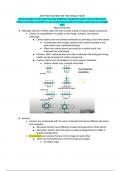 Popular
Popular
-
AP Biology notes EVERY UNIT! (taught by a Dr. in Biochemistry)
- Class notes • 57 pages • 2024
-
- $14.89
- 2x sold
- + learn more
A 57 page Google doc turned into a pdf that covers everything YOU need to know for AP Biology. My teacher is Dr. John Fuller who has a PhD in biochemistry from UCLA. Dr. Fuller has also done research in labs and contributed to academic papers, one of the most groundbreaking academic papers being about homeobox genes, which just happens to be in the cirriculum for AP Bio. There are also Google slides that Dr. Fuller has made over his 20+ years of teaching AP Biology for unit 8 and other units (...
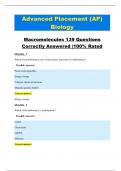
-
ADVANCED PLACEMENT (AP) BIOLOGY MACROMOLECULES 139 QUESTIONS CORRECTLY ANSWERED |100% RATED
- Exam (elaborations) • 59 pages • 2023
-
Available in package deal
-
- $10.00
- + learn more
ADVANCED PLACEMENT (AP) BIOLOGY MACROMOLECULES 139 QUESTIONS CORRECTLY ANSWERED |100% RATED Question 1 Which of the following is one of the primary functions of carbohydrates? Possible Answers: Protect cell organelles Energy storage Catalyze chemical reactions Maintain genetic fidelity Correct answer: Energy storage Question 2 Which of the following is a carbohydrate? Possible Answers: Lipase Cholesterol miRNA Mannose Correct answer:

-
Advanced Placement (AP) Biology Macromolecules 139 Questions Correctly Answered |100% Rated
- Exam (elaborations) • 59 pages • 2023
-
Available in package deal
-
- $11.00
- + learn more
Advanced Placement (AP) Biology Macromolecules 139 Questions Correctly Answered |100% Rated Where does glycolysis take place in the cell? Possible Answers: Golgi body Mitochondria Nucleus Cytosol Endoplasmic reticulum Correct answer: Cytosol Questions 2
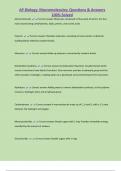
-
AP Biology: Macromolecules; Questions & Answers 100% Solved
- Exam (elaborations) • 7 pages • 2024
- Available in package deal
-
- $11.49
- + learn more
AP Biology: Macromolecules; Questions & Answers 100% Solved Macromolecules Correct answer-Molecules composed of thousands of atoms: the four main classes being carbohydrates, lipids, prteins, and nucleic acids Polymer Correct answer-Chainlike molecules, consisting of many similar or identical building blocks linked by covalent bonds. Monomer Correct answer-Make up polymers: connected by covalent bonds. Dehydration Synthesis Correct answer-(Condensation Reaction): Covalent bonds which ...
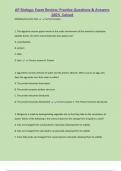
-
AP Biology: Exam Review: Practice Questions & Answers 100% Solved
- Exam (elaborations) • 94 pages • 2024
- Available in package deal
-
- $19.99
- + learn more
AP Biology: Exam Review: Practice Questions & Answers 100% Solved DNA/Biochemestry Test Correct answer--- 1. The digestive enzyme pepsin works in the acidic environment of the stomach to hydrolyze peptide bonds. On which macromolecules does pepsin act? A. carbohydrate B. protein C. DNA D. lipid Correct answer-B. Protein 2. Egg whites consist primarily of water and the protein albumin. When you fry an egg, why does the egg white turn from clear to white? A. The protein becomes d...
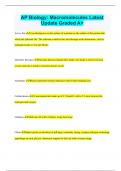
-
AP Biology: Macromolecules Latest Update Graded A+
- Exam (elaborations) • 8 pages • 2024
- Available in package deal
-
- $9.99
- + learn more
AP Biology: Macromolecules Latest Update Graded A+ Active Site A pocket/groove on the surface of a protein on the surface of the protein into which the substrate fits. The substrate is held to this area through weak interactions, such as hydrogen bonds or Van der Waals. Allosteric Enzymes Enzymes that can change their shape: one shape is active (reaction occurs) and one is inactive (reaction doesn't occur) Antibodies Bind to particular foreign substances that fit their binding si...
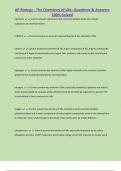
-
AP Biology - The Chemistry of Life; Questions & Answers 100% Solved
- Exam (elaborations) • 17 pages • 2024
- Available in package deal
-
- $12.99
- + learn more
AP Biology - The Chemistry of Life; Questions & Answers 100% Solved elements Correct answer-substances that cannot be broken down into simpler substances by chemical means CHNOPS Correct answer-an acronym representing the 6 key elements of life carbon Correct answer-key element of life; major component of ALL organic compounds, including all 4 types of macromolecules (sugars, fats, proteins, and nucleic acids); rarely found unbound to other elements hydrogen Correct answer-key eleme...
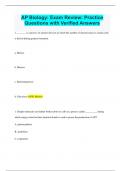
-
AP Biology: Exam Review: Practice Questions with Verified Answers
- Exam (elaborations) • 109 pages • 2024
- Available in package deal
-
- $12.49
- + learn more
AP Biology: Exam Review: Practice Questions with Verified Answers 1. _______ is a process of nuclear division in which the number of chromosomes in certain cells is halved during gamete formation. a. Mitosis b. Meiosis c. Spermatogenesis d. Glycolysis B. Meiosis 1. Simple molecules are further broken down in cells in a process called _________, during which energy stored in their chemical bonds is used to power the production of ATP. A. photosynthesis B. anabolism C. resp...

-
AP Biology Biochemistry; Questions & Answers 100% Solved
- Exam (elaborations) • 13 pages • 2024
- Available in package deal
-
- $12.99
- + learn more
AP Biology Biochemistry; Questions & Answers 100% Solved carbohydrates, lipids, proteins, nucleic acids Correct answer-Name the four major classes of large molecules in living things lipids Correct answer-What is the one class of large molecules that does not include macromolecules? macromolecule Correct answer-giant molecule formed by the joining of smaller molecules, usually by a dehydration reaction polymer Correct answer-a long molecule consisting of many similar or identical bu...

Did you know that on average a seller on Stuvia earns $82 per month selling study resources? Hmm, hint, hint. Discover all about earning on Stuvia


